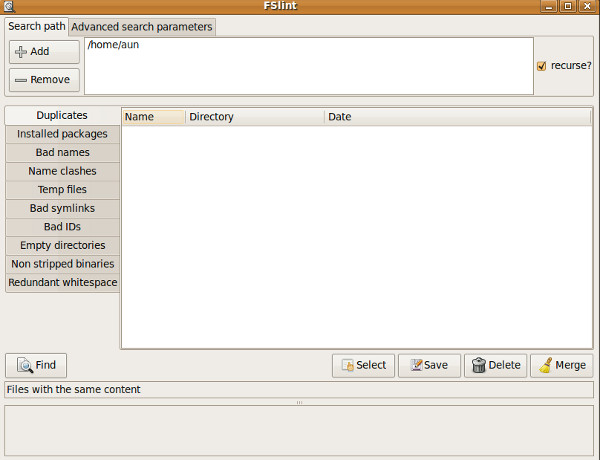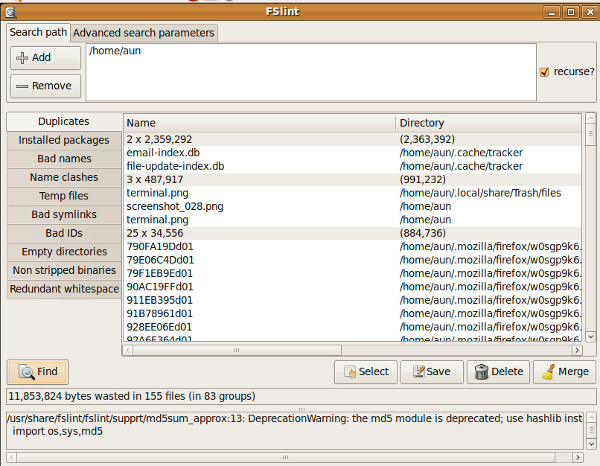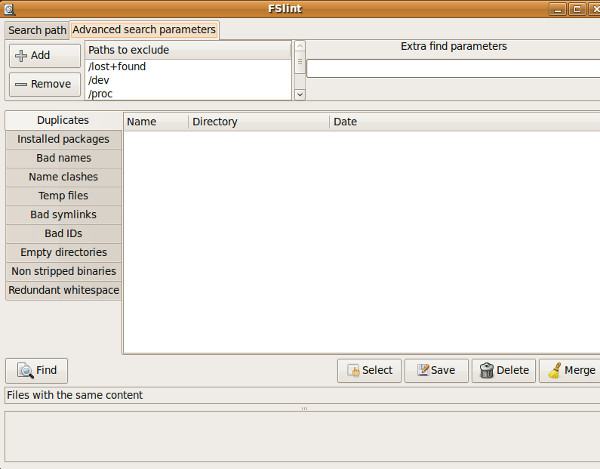Clean Up Ubuntu & Remove Duplicates With FSlint (FileSystem Lint)
FSlint (FileSystem Lint) is a cool application which lets you identify and remove duplicates from your Ubuntu system. It is a very powerful and rich tool that has the capacity to find duplicate files, installed packages, bad name clashes, temp files, bad links, empty directories, and redundant whitespace. Go through the following simple steps to install and use it.
Open the terminal and run the following command to install it:
sudo apt-get install fslint
Once the installation is completed then you can launch it from Applications->System Tools->FSlint.

You will see different buttons for every search option on the left sidebar, choose any one as per your requirement and then add the search directory by clicking the Add button. Once done, click the Find button. FSlint will go over the specified directory and display the search results according to your criteria.

Click the Delete button to remove the duplicate items. If you want to apply some specific patterns then go to the Advanced Search Parameters tab.

That’s it. Enjoy!

Good tips! I also know another tool which is very usefull in cases like this, DuplicateFilesDeleter. Thanks!
The duplicates feature in FSlint seems quite simple and straight forward. The other areas are a whole different subject. Any suggestions on how to manipulate the other segments of this package/program?
I have figured out
several of the features…I still am not sure what to do with the:
1. Installed packages (can I delete some of the duplicated packages?) IE;
linux-image-3.0.0-17-generic 152.8 MB…
linux-image-3.0.0-16-generic 152.7 MB…
linux-image-3.0.0-12-generic
152.3 MB… They are listed in this order. Each takes up a
lot of space. I would like to delete all but the most current update
(-17).?
2. Name clashes
3. Non striped binaries
and
4. Redundant whitespace
This needs some more detail in the listing view, like a directory view. Exporting the list would be great too. Also does anyone know if this does an md5 on each? Duplicate names and sizes don’t mean duplicate files.
This looks like a handy tool, I will use it to find duplicate photos, documents and music in my home directory.
I wouldn’t use this it on /dev, /proc etc. or /bin, /usr/bin etc. like on the home page:
http://www.pixelbeat.org/fslint/FSlint-1.2.png
@Amar, simply right-click a non-selected file and under “within groups” click “Select all but _____” then click “Delete”
Say I want to list the duplicate files and delete them at once (just the duplicates and not originals), what is my best bet?
Because for 100s of duplicate files it is not possible to select each one by one and doing CTRL+A or SHIFT+UP also selects the original file. Is there any work around or other GUI application for this purpose?
Maj is a holier-than-thou Troll. Face it – when you have over five terabytes of information as I do, close to six actually, do you really think it’s practical to open each folder and file manually? Give me a break. Toby you’re right, this nice tool will do the trick.
Generally this program would be good for destroying your system.
If you don’t already know how to perform these actions without a software program to help you out, you probably don’t know the implications of performing them either.
If you don’t know how to or why you would remove or change the things this program facilitates, you probably shouldn’t.
Generally this program would be good for finding duplicate files. How would you exactly do that without using a program? Combing through the directories by opening them one by one, taking notes of their contents on a piece of paper?If you don't know how to or why you should reply to articles you probably shouldn't.